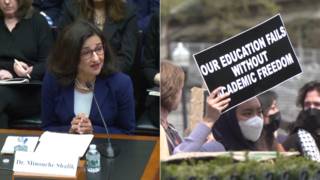
Related
Guests
- Laura Kaplanauthor of The Story of Jane: The Legendary Underground Feminist Abortion Service and former member of the underground abortion group Jane.
- Alice Foxformer member of the underground abortion group Jane.
“Ask for Jane.” Those were the magic words that provided thousands of women access to safe abortions before the landmark Roe v. Wade ruling in 1973 that guaranteed the constitutional right to abortion. With abortion services outlawed in most of the country, women often had to risk their own lives in order to terminate pregnancy. So, in 1969, a group of women in Chicago decided to take matters into their own hands and set up a hotline, offering counseling and eventually providing abortion services themselves. To reach the underground feminist abortion service, all you had to do was call a phone number and ask for Jane. We speak with two former members of Jane: Laura Kaplan and Alice Fox. Laura Kaplan is the author of “The Story of Jane: The Legendary Underground Feminist Abortion Service.”
Transcript
AMY GOODMAN: This is Democracy Now! I’m Amy Goodman. On Thursday, Louisiana became the fifth state to ban abortions after six weeks, when the Democratic governor, John Bel Edwards, signed the new measure into law. The law does not include exceptions for rape or incest. However, the ban will go into effect [only] if neighboring Mississippi’s abortion ban is upheld. A federal judge temporarily blocked the Mississippi ban last week. In addition to Louisiana and Mississippi, Kentucky, Ohio and Georgia have also recently moved to outlaw abortions after six weeks, while Missouri passed an eight-week abortion ban earlier this week. Alabama has passed a near-total ban on abortions.
Architects of the recent wave of draconian abortion laws say they’re aimed at overturning Roe v. Wade, the landmark 1973 Supreme Court ruling that recognizes the constitutional right to an abortion. Well, before the landmark Roe ruling in '73, women in many parts of the country who were seeking abortions turned to oftentimes dangerous alternative solutions. In 1969, a group of women in Chicago decided to take matters into their own hands, setting up a hotline offering counseling and providing abortion services under the moniker “Jane.” This is an excerpt of the 1996 documentary Jane: An Abortion Service. It's directed by Kate Kirtz and Nell Lundy.
SUNNY CHAPMAN: I went to a doctor who just treated me like dirt. He said, “If you girls would keep your legs together, you wouldn’t have to be coming in here until after you got married.”
TV PATIENT: Doctor, I need help!
MARIA: I remember saying to the doctor, after paying him all the money I had, “What am I supposed to do?” And his response was, “Well, you’ve got to go out there and find the father. And, you know, he’s going to have to marry you.”
LORRAINE: It was really a time when if you needed an abortion, for whatever reason, you took your life in your hands, and you were terrified. Absolutely terrified. All you knew was that you might die, that this person didn’t know what he was doing, and he was going to take hundreds of dollars, and you were going to bleed to death in some motel room.
MADELINE SCHWENK: I thought my life was going to be making soufflés and setting exquisite tables and cooking wonderful gourmet food and just being the perfect hostess for whatever lifestyle we were going to have. If somebody had told me that I was going to get arrested for abortion and conspiracy to commit abortion 10 years later, I would have said they were out of their minds.
HEATHER BOOTH: In 1965, after I had returned from Mississippi, a friend of mine said that his sister was pregnant and was very frightened and was looking for a doctor to perform an abortion. And while I had never really thought about the issue before, and wasn’t sure what to do, either, I made some calls and contacts and located a physician who was willing to perform an abortion.
JEANNE GALATZER-LEVY: Abortion was illegal. The hospital and doctors wanted no part of any abortion and were not willing to even see you if they suspected an abortion. So, a woman bleeding and possibly dying could be sent away from a hospital.
SUNNY CHAPMAN: Everybody I knew, everybody I talked to who had become pregnant and didn’t want to have a baby and had tried to abort, had done something really painful or horrible. And they were all hysterical and desperate, just like I was. Just hysterical, desperate and scared. Scared.
HEATHER BOOTH: Several months later, word of that had spread, and someone else contacted me. And then, several months later, word had spread again, and someone else contacted me. And I realized that there was a real need out there. And I decided to set up a system for talking with women who were trying to figure out what to do. And I set up what became known as “the Service,” or Jane.
AMY GOODMAN: That last voice, Heather Booth, from an excerpt of the 1996 documentary Jane: An Abortion Service, directed by Kate Kirtz and Nell Lundy, distributed by Women Make Movies.
By the time Roe v. Wade was passed in 1973, the Jane Collective had performed an estimated 11,000 abortions.
We’re joined by two former members of Jane: Alice Fox and Laura Kaplan. Laura is also the author of the book, The Story of Jane: The Legendary Underground Feminist Abortion Service, which was recently reprinted.
We welcome you both to Democracy Now! So, day after day now, abortion bans are being passed around the country. It’s not that those who want these bans in place necessarily think that lower courts will keep them in place, but they want one of these cases to get to the Supreme Court to overturn Roe v. Wade. As you watch this, Laura Kaplan, taking place around the country, your thoughts and what it means to have been active around this issue before Roe v. Wade existed?
LAURA KAPLAN: Well, it’s really horrifying. It’s just this giant leap backwards in terms of the respect for women and women’s decisions. It’s horrifying. You know, I’m just amazed every day.
AMY GOODMAN: Talk about how you got involved with Jane.
LAURA KAPLAN: Well, it’s great that Alice is here, because Alice is the reason I got involved with Jane. I had moved back to Chicago. I had gone to school there and then moved back to New York, where I’m from, and moved back to Chicago in 1971. And shortly thereafter, my dear friend from college, Alice, found out she was pregnant, so… Do you want her to tell her story?
AMY GOODMAN: Yeah, I do.
ALICE FOX: Hi there. At that time, there was no question of me remaining pregnant. I was in a new relationship, and abortion was already legal in New York, so I knew—I had enough knowledge to know that that was an option for me. And it was clearly—it was not a decision I had trouble making, that I needed to have an abortion at that time. Was fresh out of college myself. And interestingly—and I’m not sure I remember my thinking around that time—it didn’t really occur to me to come to New York. I really was in an independent state of mind and felt I could take care of my own life, and saw an ad about, “Pregnant? Call Jane.” And immediately, I felt confident, and from that initial interaction over the telephone—
AMY GOODMAN: What did you say? You called up, said you were pregnant.
ALICE FOX: I called the number.
AMY GOODMAN: And what did the person say? Who was it?
ALICE FOX: I think it was a message. The first one was “Please leave your name” and maybe the date of your last period. I don’t remember what the actual information was that I left on that time. But I was called back pretty promptly. I don’t recall being in a state of waiting very long.
And I then met with a counselor at that time, and she gave me all the information about what would happen. And I was in her home, with her young children running around. And I was—I felt totally comfortable, confident, not frightened. You know, I hear these stories of the worry and the fear that what lay ahead was some nightmare. I don’t recall feeling that for a moment. And I felt very proud of myself for taking care of myself. And—
AMY GOODMAN: And what happened? What did she do in this home with her kids?
ALICE FOX: So, she laid out to me exactly what would happen in the procedure, that I would be taken care of, that I would—exactly all the steps that would happen, that I would be driven to a place, that I would be safe and taken care of, that someone would be by my side the whole time, and that the procedure—she described the procedure itself, which at that time was a D&C—and that I would be—I think I was taken with a group of women so that I wasn’t by myself. There was a few women—maybe Laura can correct me, but that’s my memory, that there were a few people each time that a procedure was scheduled. And she described the procedure in detail, which, again, was an incredibly—I don’t think I had ever been described a medical procedure before by someone saying, “This is exactly what’s going to happen.” And I was prepared.
AMY GOODMAN: We’re going to go to break, and when we come back, we’re going to hear the voices of women who, like you, went through this, this abortion service Jane put in place so that women would not have to go to backstreet alleys. But the people involved with this abortion service were not doctors themselves. We’re talking to Alice Fox and Laura Kaplan, both members of the Jane Collective. Laura Kaplan wrote about this in her book, The Story of Jane: The Legendary Underground Feminist Abortion Service. Stay with us.
[break]
AMY GOODMAN: “The Most Beautiful Garden,” featured in the film Ask for Jane, about the Jane Collective. This is Democracy Now! I’m Amy Goodman. “Ask for Jane.” Those were the magic words that provided thousands of women access to safe abortions before the landmark Roe v. Wade ruling in 1973 that guaranteed the constitutional right to abortion. With abortion services outlawed in most of the United States, women often had to risk their lives in order to terminate a pregnancy. So, in 1969, a group of women in Chicago decided to take matters into their own hands, setting up a hotline offering counseling and actually providing abortion services under the name Jane.
This is Heather Booth, who founded Jane when she was a college student at University of Chicago. Here she is in the 1996 documentary Jane: An Abortion Service.
HEATHER BOOTH: The people who called in the early years, it was mostly a student network, first at the University of Chicago, then from other Chicago-based schools and then on through other campuses in the Midwest. And my recollection is that I was receiving some of these calls when I was living in a dormitory, and I told people who called to ask for Jane, so it was anonymous.
AMY GOODMAN: With time, activists with Jane went from referring women for abortions to performing the abortions themselves. Here’s another clip from the documentary.
HEATHER BOOTH: First, there was a physical level of involvement.
UNIDENTIFIED: We would drop them off, and then one of Mike’s people would pick them up and blindfold them and take them to a building where the abortion would be done. And then they would be dropped back off.
JUDITH ARCANA: A lot of guys who do abortions come on to the women and are abusive, either on moral and ethical grounds—which is kind of ridiculous when you think about it, like, “Oh, you got yourself in trouble,” or “You’re a bad girl,” or, you know, that kind of thing—or the sexual approach. Our guy, none of that.
RUTH SURGAL: He came from—I don’t even think working-class, I think even poorer than working-class, and the kind of—where you don’t trust anybody, and everybody’s out for themselves.
JODY PARSONS: The first thing he said—I guess he said to Ruth and to me, both—was “We can’t meet together. Only two of us at a time, because if more than two meet, it’s a conspiracy.” So, first, he and Ruth go off and have their little chat. And then they say, “OK”—Ruth comes in, says, “OK, you can go down now.” And I go off alone with him. And we just talked money. I said, “Look, let’s talk money.” And he said, “That’s what I want to talk about.” And we struck a deal right away. I said, “Come down on your price.” And he says, “No, we’re not coming down below $500.”
UNIDENTIFIED: All of us women, I’m sure, felt that the fee of $500 or $1,000 was extraordinarily exploitative and made it impossible for a lot of people to get abortions who needed them. So, when it became clear that this was not an especially difficult thing to do, pressure was put on him to teach us. Say, “Hey, you know, this looks like something we can do.” And amazingly, he thought it was, too, and that that wasn’t such a bad idea.
JUDITH ARCANA: The blindfolds came off, and the prices were coming down, and those of us who had known him the longest were also beginning to learn and, very quickly—very quickly—training others of us, so that I, who had come in in October of '70, by the beginning of ’71, was one of the people who had already begun to do long-term abortions on an extra day that we added where we were the only staff. We didn't have him; it was just us.
JEANNE GALATZER-LEVY: What we did was we broke the bag of waters and pushed out the water, and then, over a period of time, the fetus would die, and the woman would miscarry.
JODY PARSONS: After I took the instrument in my hand, you know, he said, “Here, feel what it feels like. Here is the feeling you’re looking for.” And, man, I could close my eyesm, and I could just—I could feel it exactly, exactly the feeling. And I thought, “I can do this.” And all of a sudden, this just vista opened up.
JUDITH ARCANA: Also, somewhere in that period, the group discovered—I don’t know if “discovered” is the right word; I’m not quite sure what the right verb is here. It was known, suddenly, that he was not an M.D.
RUTH SURGAL: And then Mike was gone.
JODY PARSONS: Well, he had already made enough money. The Mafia had moved in on him. Also, he believed in what we were doing.
AMY GOODMAN: A clip from the documentary Jane: An Abortion Service, directed by Kate Kirtz and Nell Lundy, distributed by Women Make Movies. Still with us, the two former members of Jane, Alice Fox and Laura Kaplan. Laura Kaplan has also written the book The Story of Jane: The Legendary Underground Feminist Abortion Service, which was recently reprinted.
This service went on for about four years, until Roe v. Wade became the law of the land. Talk about the bust of the women, the police moving in, in Chicago, on this abortion service—again, abortions performed by women, not doctors, who were fearful that if women didn’t have something like this, when abortion was illegal, that they could die from back-alley abortions. Laura?
LAURA KAPLAN: I’m going to talk specifically about the bust. So, the bust happened on a very lovely May day. And what we found out was that a sister-in-law of a woman scheduled had come with her—we encouraged people to come with someone to the counseling session in their counselor’s home. So this woman had brought her sister-in-law, who didn’t like what she heard. So she went to her precinct.
And so, the police followed the driver. As Alice described, we had people gather at a place called a “Front,” which was a front. And then, in small groups, they were driven to another apartment or a house that we called “the Place,” because that’s where we did the abortions—very creative with names. So, the police followed the driver a couple of times, and then they barged in, while we were working. And they wanted to know where the man was and where the money was. And, of course, there wasn’t much in the way of money. We charged a hundred dollars. We got probably an average of $40, $40 or $50 per person. And there was no man. It was just us.
So they arrested everybody who was at the Place. They then went to the Front and arrested everybody there, so they had a police station full of—because we had people bring whoever they wanted with them to the Front, and so there were children and husbands and mothers and friends and, you know, quite a large group of people in the police station.
AMY GOODMAN: How many of you were charged?
LAURA KAPLAN: Seven.
AMY GOODMAN: And you were charged with? Jane members were charged?
LAURA KAPLAN: Abortion and conspiracy to commit abortion.
AMY GOODMAN: Facing how many years?
LAURA KAPLAN: These are felonies. Homicide squad detectives were the ones who busted us. A lot of years.
AMY GOODMAN: Final thoughts, Alice? Of course, this case was dropped when Roe v. Wade became the law the land.
ALICE FOX: You know, in light of everything now, it’s amazing to kind of look back at that time and to see that it was sort of part of a very active political time in all of our lives. We had come—I mean, this was the early—
AMY GOODMAN: Do you see women going back to this?
ALICE FOX: Well, it’s hard to imagine that we would have to go back to this, but I also think that having gone into healthcare for many years, that it was an incredible example.
AMY GOODMAN: Well, we’re going to leave it here for now. We’re going to do Part 2 and put it in web exclusives at democracynow.org. Laura Kaplan, Alice Fox, members of Jane. Laura Kaplan’s book, The Story of Jane.











Media Options